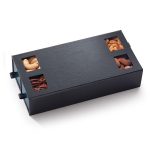
In the bustling landscape of modern food consumption, plastic food packaging boxes have quietly revolutionized how we store, transport, and enjoy our meals. These unassuming containers have become indispensable companions in our daily lives, offering convenience, protection, and versatility that often goes unnoticed. From takeout dinners to meal prep solutions, plastic packaging boxes have seamlessly integrated into our culinary experiences, proving that sometimes the simplest innovations make the most significant impact.
The evolution of plastic food packaging represents a fascinating journey of material science meeting practical necessity. Modern plastic containers are engineered with precision, incorporating features like secure locking mechanisms, microwave-safe materials, and compartmentalized designs that keep different food items separated and fresh. These advancements have transformed basic food storage into a sophisticated system that maintains food quality while enhancing user convenience. The humble plastic box has become a masterpiece of functional design, balancing practicality with environmental considerations through recyclable and reusable options.
One of the most remarkable aspects of plastic food packaging boxes is their incredible versatility. They accommodate everything from steaming hot soups to delicate pastries, from crunchy salads to saucy main courses. The variety of sizes, shapes, and specialized designs available today demonstrates how manufacturers have responded to diverse culinary needs. Whether it’s a transparent container that showcases a chef’s culinary creation or a sturdy box that protects fragile baked goods during transportation, plastic packaging has become an essential tool for both food businesses and consumers alike.
Beyond mere convenience, plastic food packaging boxes play a crucial role in food safety and preservation. Advanced materials create barriers against moisture, oxygen, and contaminants that can compromise food quality. This protective function extends the shelf life of perishable items, reduces food waste, and maintains nutritional value. For health-conscious consumers and busy professionals alike, these containers provide peace of mind knowing that their meals remain fresh, safe, and delicious until consumption.
The environmental aspect of plastic food packaging has sparked important innovations in sustainable design. Many manufacturers now prioritize recycled materials and develop packaging that can be reused multiple times before recycling. The industry’s growing commitment to circular economy principles has led to the creation of boxes made from post-consumer recycled plastic and designs that minimize material usage without compromising functionality. These eco-conscious approaches demonstrate how plastic packaging can coexist with environmental responsibility.
Looking toward the future, plastic food packaging boxes continue to evolve with emerging technologies and changing consumer preferences. Smart packaging incorporating QR codes for tracking freshness, anti-microbial surfaces, and even self-heating capabilities represent the next frontier in food container innovation. As sustainability concerns drive further development, we can expect to see more breakthroughs in biodegradable plastics and closed-loop recycling systems that make plastic packaging an even more responsible choice for environmentally aware consumers.
In our fast-paced world, plastic food packaging boxes have become silent partners in our culinary adventures. They enable the convenience of food delivery services, support meal preparation routines, and facilitate the sharing of homemade treats with friends and family. While often overlooked, these practical containers deserve recognition for their role in making modern food culture possible. As technology advances and environmental awareness grows, plastic food packaging will continue to adapt, ensuring that this essential innovation remains relevant, sustainable, and invaluable to how we experience and enjoy food in our daily lives.




Leave a Message